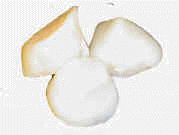|
|
|
|||||||||
Sea Scallops Placopecten megallanicus Sea Scallops have a mild and briny taste with a texture hat is lean and firm. The large size and characteristic scallop shape make these a popular variety. Sea Scallops grow to 8 inches across producing muscle meat averaging 1 to 2 inches across. Compared to the bay scallop, it takes about 20 to 30 sea scallops to make up a pound where the bay would need 70 to 90 for a pound. The Sea Scallop is harvested year round in Atlantic waters from Labrador to New Jersey in waters up to 900 feet deep. The Sea scallop is always shucked on the boat and kept on ice or frozen at the time of harvest. Wet or soaked scallops have a shiny opaque look and a soapy feel. These scallops may have a pronounced after taste and should be avoided. Top quality scallops should have an ivory translucent appearance with firm springy feel that allows them to keep their shape
While scallops are commonly eared cooked, bays are sometimes eaten raw due to their size and freshness. Like clams and oysters, scallops may carry Vibrio vulificus. Though not a common occurrence, this does present a health hazard to people with compromised immune systems.
|
||||||||||
|
|
||||||||||

